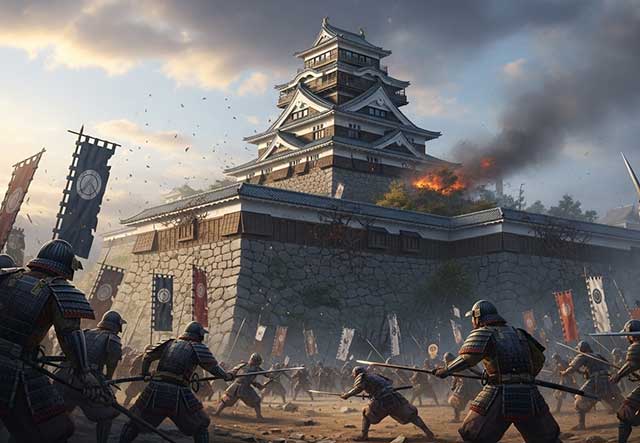
The battle for Kozuki Castle was a consequence of Oda Nobunaga's expansion in the Chugoku region. Toyotomi Hideyoshi was appointed to lead the campaign, which aimed to weaken the influence of the Mori clan in these lands. Under his command were famous samurai: Kuroda Kanbei, Takenaka Shigeharu, and Hachisuka Koroku. Amago Katsuhisa, who cherished the hope of one day restoring the Amago clan's lost dominance in western Japan, also joined Oda's army.
The commander of Kozuki Castle, Akamatsu Masanori, refused to recognize Oda Nobunaga's authority, and in December, Hideyoshi's troops began to capture the outer posts that reinforced the approaches to the fortress. Later that month, the Ukita clan, which was allied with the Mori clan at the time, sent an army to help the garrison. However, Ukita's forces were intercepted and defeated by Hideyoshi's army.
When Ukita's attack was repelled and no support came from the Mori clan, Hideyoshi offered Akamatsu the chance to surrender. After he refused, Hideyoshi ordered a final assault. The castle was taken, but both sides suffered heavy losses. Akamatsu Masanori chose to kill himself rather than be taken prisoner. By the time the Oda army's banners flew over the fortress, about a thousand of its defenders were already dead.
After the capture, Kozuki Castle was handed over to Amago. In 1578, it was recaptured by the Ukita clan, but soon the fortress returned to Amago control. Some time later, the main forces of the Mori clan approached the castle and began a siege. At that time, Oda's army was busy storming Miki Castle, so no help was sent. As a result, Kozuki fell again, and with it, Katsuhisa's hopes of reviving the former power of the Amago clan collapsed.
See also
-
The Siege of Hara Castle

The Shimabara Rebellion of 1637–1638, which culminated in the siege of Hara Castle, was the last major uprising of the Edo period and had serious political consequences.
-
Battle of Tennoji

The confrontation between Tokugawa Ieyasu and Toyotomi Hideyori during the “Osaka Winter Campaign” ended with the signing of a peace treaty. On January 22, 1615, the day after the treaty was signed, Ieyasu pretended to disband his army. In reality, this meant that the Shimazu forces withdrew to the nearest port. On the same day, almost the entire Tokugawa army began filling in the outer moat.
-
Siege of Shuri Castle

The Ryukyu Kingdom was established in 1429 on Okinawa, the largest island of the Ryukyu (Nansei) archipelago, as a result of the military unification of three rival kingdoms. In the following years, the state's control spread to all the islands of the archipelago.
-
The Siege of Fushimi Castle

Fushimi can perhaps be considered one of the most “unfortunate” castles of the Sengoku Jidai period. The original castle was built by Toyotomi Hideyoshi in the southeast of Kyoto in 1594 as his residence in the imperial city.
-
The Siege of Otsu Castle

The siege of Otsu Castle was part of the Sekigahara campaign, during which the so-called Eastern Coalition, led by Tokugawa Ieyasu, fought against the Western Coalition, led by Ishida Mitsunari. Otsu Castle was built in 1586 by order of Toyotomi Hideyoshi near the capital Kyoto, on the site of the dismantled Sakamoto Castle. It belonged to the type of “water castles” — mizujō — as one side of it faced Japan's largest lake, Lake Biwa, and it was surrounded by a system of moats filled with lake water, which made the fortress resemble an island.
-
The Siege of Shiroishi Castle

The siege of Shiroishi Castle was part of the Sekigahara campaign and took place several months before the decisive battle of Sekigahara. The daimyo of Aizu Province, Uesugi Kagekatsu, posed a serious threat to Tokugawa Ieyasu's plans to defeat the Western Coalition, and Ieyasu decided to curb his actions with the help of his northern vassals. To this end, he ordered Date Masamune to invade the province of Aizu and capture Shiroishi Castle.
-
The Second Siege of Jinju Castle

During the two Korean campaigns of the 16th century, the Japanese repeatedly had to capture enemy fortresses and defend occupied or constructed fortifications from the combined Korean and Chinese forces. Among all the operations of that time, the second siege of Jinju Castle is considered the most interesting from the point of view of siege warfare.
-
The Siege of Takamatsu Castle

The siege of Takamatsu Castle in Bitchu Province is considered the first mizuzeme, or “water siege,” in Japanese history. Until then, such an original tactic had never been used.

